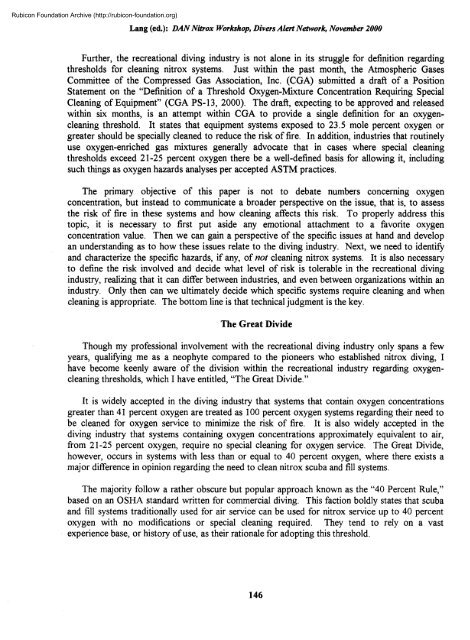Nitrox workshop dings - Divers Alert Network
Nitrox workshop dings - Divers Alert Network
Nitrox workshop dings - Divers Alert Network
Create successful ePaper yourself
Turn your PDF publications into a flip-book with our unique Google optimized e-Paper software.
Rubicon Foundation Archive (http://rubicon-foundation.org)Lang (ed.): DAN <strong>Nitrox</strong> Workshop, <strong>Divers</strong> <strong>Alert</strong> <strong>Network</strong>, November 2000Further, the recreational diving industry is not alone in its struggle for definition regardingthresholds for cleaning nitrox systems. Just within the past month, the Atmospheric GasesCommittee of the Compressed Gas Association, Inc. (CGA) submitted a draft of a PositionStatement on the "Definition of a Threshold Oxygen-Mixture Concentration Requiring SpecialCleaning of Equipment" (CGA PS-13, 2000). The draft, expecting to be approved and releasedwithin six months, is an attempt within CGA to provide a single definition for an oxygencleaningthreshold. It states that equipment systems exposed to 23.5 mole percent oxygen orgreater should be specially cleaned to reduce the risk of fire. In addition, industries that routinelyuse oxygen-enriched gas mixtures generally advocate that in cases where special cleaningthresholds exceed 21-25 percent oxygen there be a well-defined basis for allowing it, inclu<strong>dings</strong>uch things as oxygen hazards analyses per accepted ASTM practices.The primary objective of this paper is not to debate numbers concerning oxygenconcentration, but instead to communicate a broader perspective on the issue, that is, to assessthe risk of fire in these systems and how cleaning affects this risk. To properly address thistopic, it is necessary to first put aside any emotional attachment to a favorite oxygenconcentration value. Then we can gain a perspective of the specific issues at hand and developan understanding as to how these issues relate to the diving industry. Next, we need to identifyand characterize the specific hazards, if any, of not cleaning nitrox systems. It is also necessaryto define the risk involved and decide what level of risk is tolerable in the recreational divingindustry, realizing that it can differ between industries, and even between organizations within anindustry. Only then can we ultimately decide which specific systems require cleaning and whencleaning is appropriate. The bottom line is that technical judgment is the key.The Great DivideThough my professional involvement with the recreational diving industry only spans a fewyears, qualifying me as a neophyte compared to the pioneers who established nitrox diving, Ihave become keenly aware of the division within the recreational industry regarding oxygencleaningthresholds, which I have entitled, "The Great Divide."It is widely accepted in the diving industry that systems that contain oxygen concentrationsgreater than 41 percent oxygen are treated as 100 percent oxygen systems regarding their need tobe cleaned for oxygen service to minimize the risk of fire. It is also widely accepted in thediving industry that systems containing oxygen concentrations approximately equivalent to air,from 21-25 percent oxygen, require no special cleaning for oxygen service. The Great Divide,however, occurs in systems with less than or equal to 40 percent oxygen, where there exists amajor difference in opinion regarding the need to clean nitrox scuba and fill systems.The majority follow a rather obscure but popular approach known as the "40 Percent Rule,"based on an OSHA standard written for commercial diving. This faction boldly states that scubaand fill systems traditionally used for air service can be used for nitrox service up to 40 percentoxygen with no modifications or special cleaning required. They tend to rely on a vastexperience base, or history of use, as their rationale for adopting this threshold.146
















